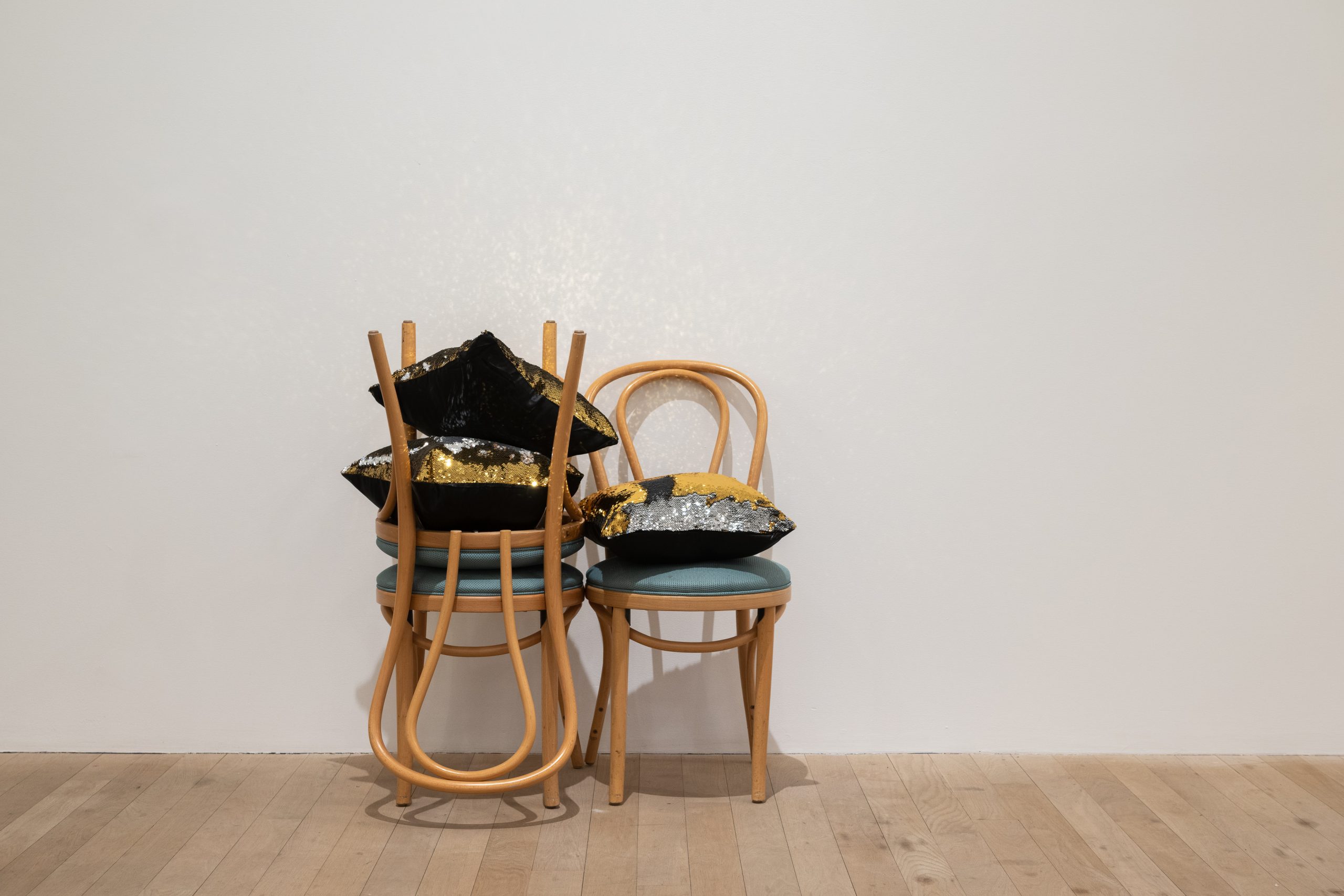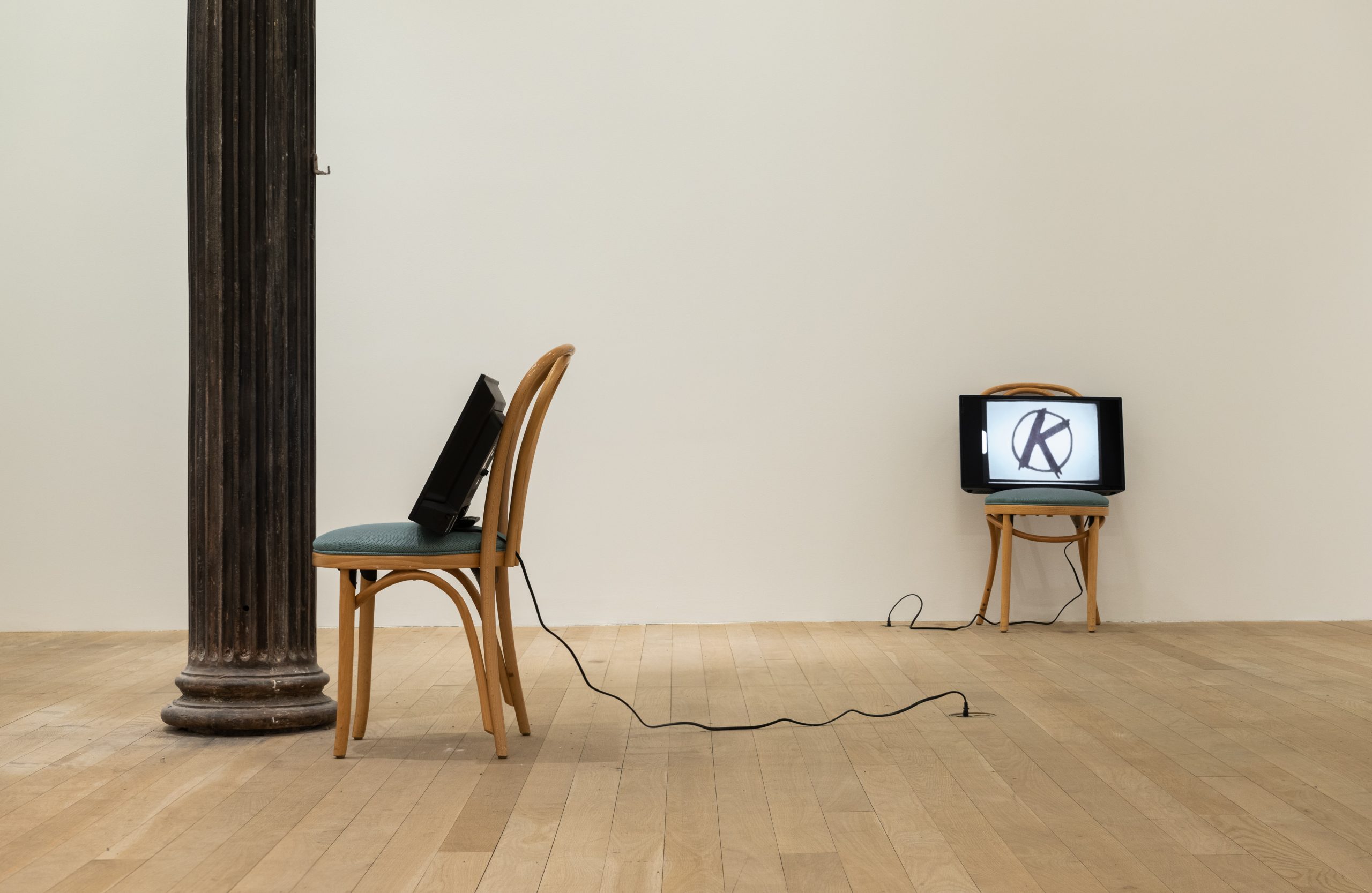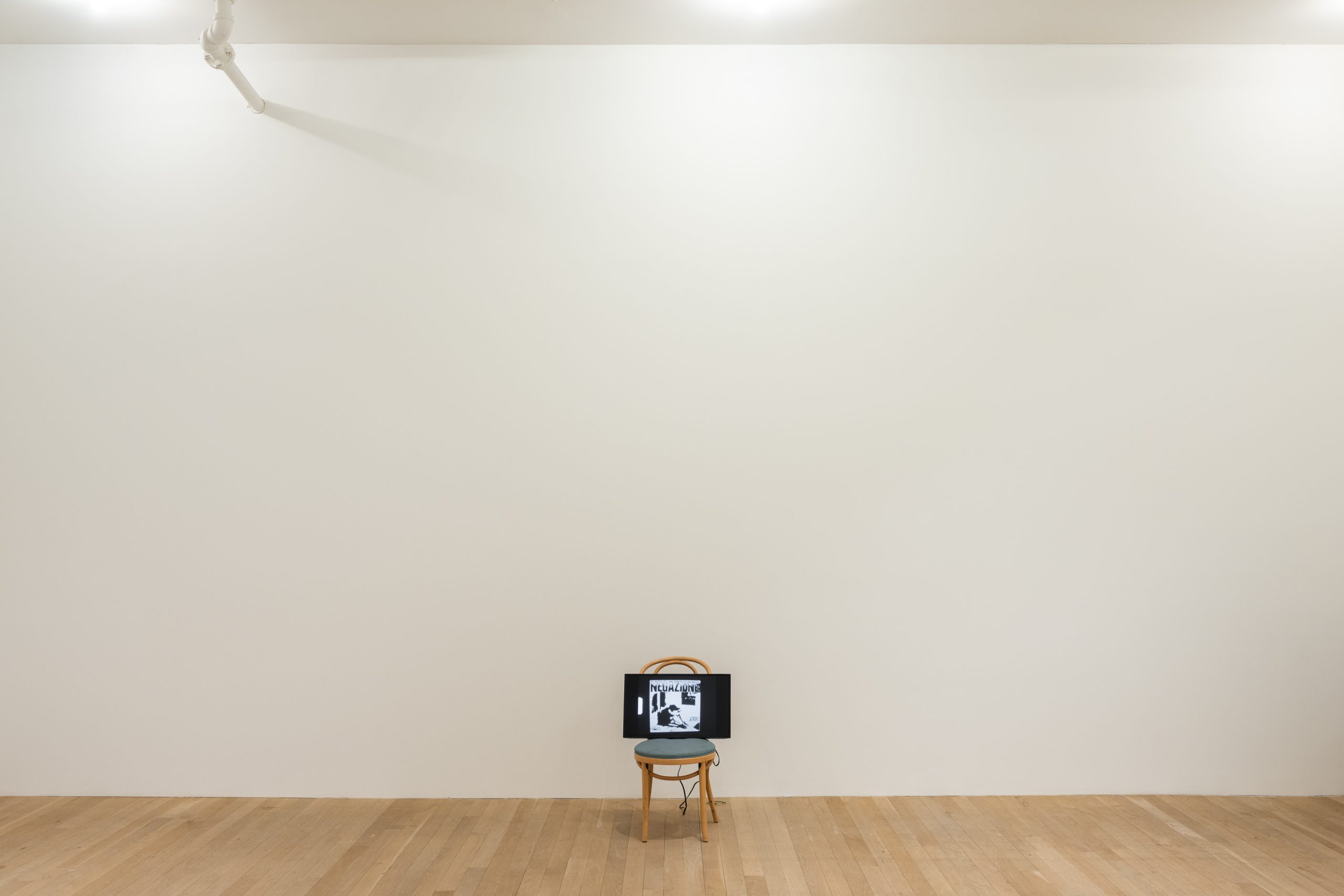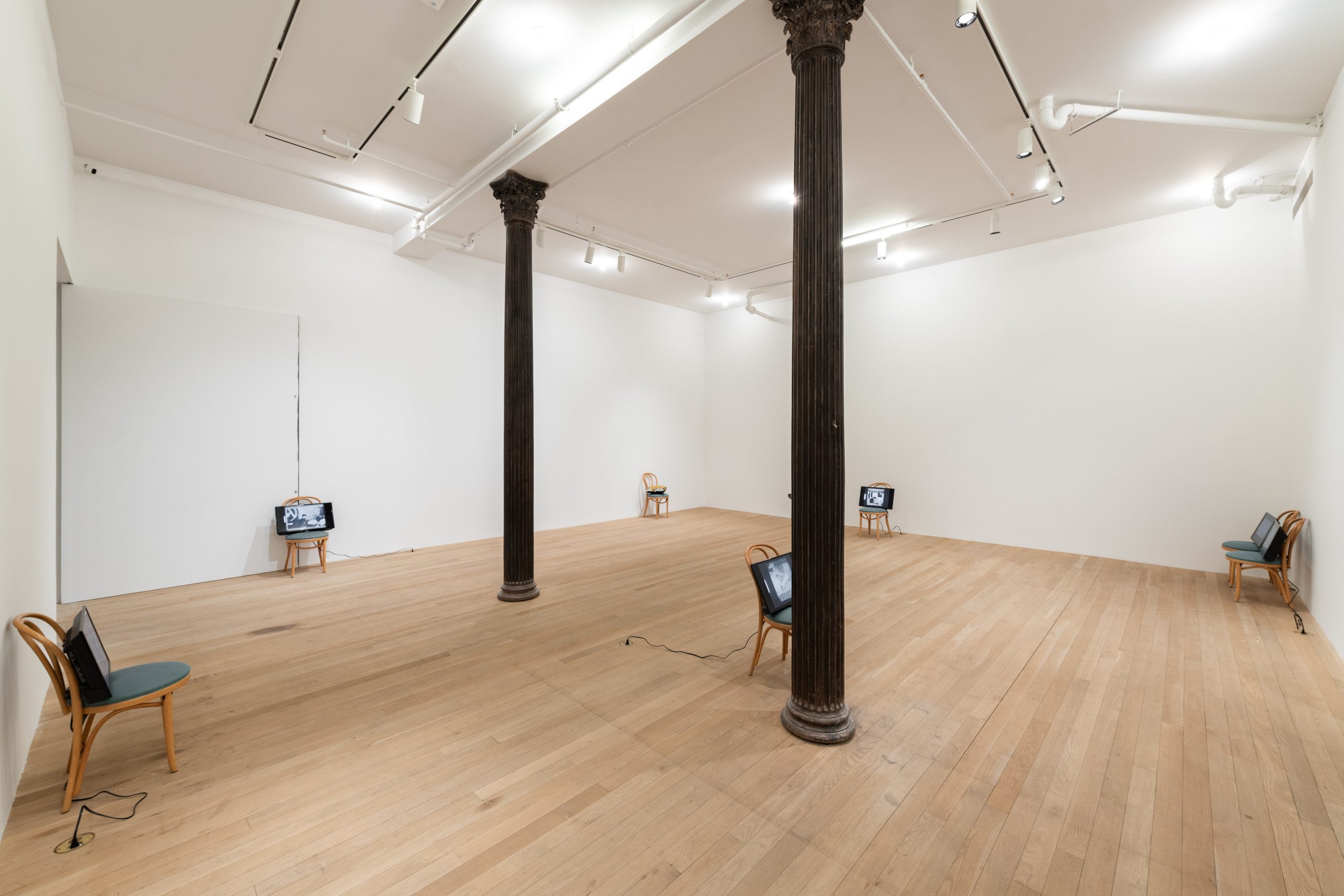Nicole-Antonia Spagnola: Anti-Genesis
In the first feature commissioned by Laura McLean-Ferris as Topical Cream’s 2022 Editor-in-Residence, Paige K. Bradley reviews Nicole-Antonia Spagnola’s exhibition Anti-Genesis at Artists Space, New York.
Punk’s dead. Punk’s not dead. Two hackneyed phrases of the English language, at least in the contemporary vernacular sense. And such sayings imply a binary, or a choice to be made, which is also like saying, “Which way, restless youths?” Though motley crews of SoundCloud rappers have more recently dominated the space in culture reserved for hedonism, self-destruction, and antisocial rebellion, with a touch of Gnostic mysticism,1 it’s the bands—an umbrella term under which huddles the impulse to start one, the full spectrum of bullshit and glamor that comes with actually being in one, and recollections of having been in one during some halcyon period—that are due for a comeback. Mark it.
Nicole-Antonia Spagnola, for one, is in a band. Two, actually, including Purity, which released one album back in 2016 on artist and designer Brendan Fowler’s Some Ware label titled Live in Los Angeles—recently rereleased on Post Present Medium—composed entirely of hollowed-out covers of punk and New Wave songs.2 Think Negative Approach’s “Ready to Fight” reformulated as an anthem for a dog that, rather than being young and raring to go, has been beaten down many times over, and is held upright by its now-constant, instinctual rage. No keeping a good dog down, though. Spagnola’s other band, P22, has a name that one might associate with a model of semi-automatic pistol, but the slightly less threatening namesake of the group comes from the identificatory code-name for an intrepid mountain lion who bootstrapped himself up from the Santa Monica Mountains and crossed the 405 and 101 freeways of Los Angeles ten years ago to take up residence in a more desirable zip code.3 The screen printed poster advertising their twelve-inch EP Human Snake declares:
“The animal takes its stand on the plant, man bestrides animality, and the whole of humanity, in space and in time, is one immense army galloping beside and before and behind each of us in an overwhelming charge able to beat down every resistance and clear the most formidable obstacles, perhaps even death.”
That’s hardcore. And Spagnola’s first institutional solo show, Anti-Genesis (Artists Space, New York, 2022), features Italian hardcore, which is to say, four single television monitors, and one pair of the same, all playing YouTube-hosted recordings from groups like Negazione, RAF Punk, and Antigenesi, mostly associated with a squat in Milan that was called Virus. They were re-filmed on 8mm by the artist pointing her camera at the computer screen, and then converted back again to MP4 video for looping on the TV sets, leaning on an array of stained cafe chairs, all scavenged by Artists Space for this installation. Arts institution as freegan dumpster diver! Well, the venue is in an alley just a stone’s throw away from the former Mudd Club. Ask a punk. It’s true that this ain’t no Mudd Club, but, if I may, this also ain’t no fooling around, despite the other three chairs in the show winsomely offering up gold- and silver-sequined pillows that the artist got off Amazon.com. The patterning of the sequins is jagged, like an approximation of tattered t-shirts, worn in layers. It’s defiantly not very punk! Ergo, it’s fucking punk rock. Spagnola’s relationship with the original recordings she is representing, or covering, is that of a digital native. These circa-1980s tracks hail from rare vinyl records that might come up on sites like Discogs, for many dollars, so the original—itself a very abstract concept, the cultural value of which may well be less than that of the records’ resale values—is very far back in this scenario which Spagnola is staging. The only discernible similarity is length: three-to-four-minute songs, so three-to-four-minute videos. What kind of show is this? A pizza box I threw out last week had a slogan printed on it that could shed light on this point: “Traditional Italian Contemporary Taste.” Here’s another clue: The lighting of this exhibition involves Artists Space’s emergency fluorescents, not generally used for shows at all. This excessive light is a perfect inversion of another kind of past: Anti-Genesis itself is a version of Italian Hardcore, a similar constitution of works Spagnola showed last summer at Commercial Street in Los Angeles.

The opening there was at night, the chairs were red and black, and the TVs glowed in the darkness sans lighting, like the videos one is destroying their eyes with by watching them on a phone in bed in the middle of the night. But at the DIY gig, in the event of a problem, the house lights might come on—“does anyone need help?” Perhaps this specific kind of illumination in New York gestures toward an overexposure of the once-underground by legacy institutions. Like some rare botanical, culture, too, might benefit from being left alone to grow in the dark sometimes. But then again, throwing the lights on can also be a sign of care, or a willingness to disrupt, and the code of conduct at any underground show of conscience is you pick people up when they fall: no matter how aggressive things get while everyone’s still standing, no one should be stomped on. There’s a heritage of certain ethical values that can only be passed on, absorbed, through witnessing, and demonstration. If the neoliberal institution par excellence—cheers!—is all about doing what they say, rather than as they do, at least a band that produces unintelligible music can enact their principles before, during, and after the set. People will show you who they are.
Accordingly, listening is itself de-emphasized in Spagnola’s installation, since the videos, like loud crosstalk in a crowded room, are playing continuously and at the same time. What you’ll hear is a cacophony of simultaneity, of iterations across time and media formats, and what you’ll see is a flicker of a piece of cover art, hovering like some bootlegged ghost broadcast from a dithered signal. Think of a Chris Marker film, but stuttering in shock at being edited down into a short, hazy memory. The format of a video exhibition remains haunted by the conventions of television, even if the digital platforms of unlimited streaming have scuttled the home programming schedules instituted by the cathode ray. But the asymmetric, unequal social relation between “sending” and “receiving” in television,4 noted by poet and critic David Antin for an essay back in 1975—proto-punk?—also lurks in the contextual undertow of Spagnola’s use of content lifted from a website that also exploits what it knows about its user, and with no direct malice, just algorithmic protocol. The cheat, the grift, the data farming; all very contemporary, which is easy to forget if one wants to get lost in the sauce of the apparent material—hardcore punk—rather than the underlying mode of working and re-working as a meditation on time and identification. But are we in 2022, or 1982? Maybe all the dizzying interchanges of multimedia theft are the only way to know we’re in the Now. The artist is an unhelpful stenographer—the best kind—cataloging a certain set of signifiers of affiliation. Recherché as these signals might seem at first, they serve as but one set of codes to an essential operation: how an individual, or groups of such, must mark themselves to semaphore allegiances, or even warnings. Take “I’m Italian,” or, “I’m hardcore.” What could that mean at this point in time? Spagnola will show you as she goes along in it. For now, it’s the sound of many rooms here—that of the recording studio as a band played, where the artist listened as she re-recorded, the acoustics of a prominent nonprofit—collapsing in on each other across time and space, and unlike an audio piece attempting to capture a location, right as one is in it, like, say, Alvin Lucier’s 1969 I Am Sitting in a Room,5 this arrangement is not live, more like undead.
Like punk, which I’ve come to think of with some distaste as a worshipful cult around personalities from the past. I don’t know anything about the individuals producing the sounds of this Italian hardcore though; what a relief! Reject the modernity of celebrity, embrace the tradition of semi-anonymity.

Lucier once said, “every room has its own melody, hiding there until it is made audible.”6 In contrast, the title of this show implies a rejection of the premise of unique material waiting to be discovered, or even the notion that anything can be traced to an origin point. Anti-Genesis is also something of a riff on the name of one of the bands—Antigenesi—being covered in this installation-as-playlist. There are different songs than in the Los Angeles iteration, but the similarity, rather than the difference, seems more important. It is, in an almost mocking sense, more of the same, rather than any wheedling attempt to change oneself to make an impression in New York. Anti-Genesis is, in a subtle way, absolutely adamant about not coming here to perform catharsis, engender excitement, or dictate nostalgia, as the rock docs and oral histories do. “You had to be there, man.” Did I? I’d rather be here, right now, milling around in this ambiguity Spagnola has created. Like the album copy for Live in Los Angeles says: “Repetition is key here, as is genre, context, being looked at, standing around, etc.” There’s no point of center, no star, no front or back here, just gestures propped up on the makeshift stage and an audience getting inflected by them, if you’re willing to show up for it. Maybe you’ll end up looking at someone else, too, while yet another watches you watching.
Flashback to when Kim Gordon wore a shirt that said, “Girls invented punk rock.” Is that true? Am I forgetting some part? So what—it’s a complete sentence and rings true. Punk’s dead; punk’s not dead, etc., etc. The circularity of Spagnola’s process with pre-existing material addresses a rhythm of release, inspire, and retire, the B-side of which is renewal, reset, and re-release. Newness is a story you want to be told without having to lift a finger yourself to play a part. The childish crave novelty, and the re-representation, or even the cover song, is a defense of a certain picture of reality—that they have been here before, and now so are we, in order that someone else might be. New troops; old cause. Or, as the artist says in a booklet for Anti-Genesis: “So the self-selected inheritors still keep on and on, writing the songs, doing the thing, showing up to play out our outmoded productive affinities.”

Or, “here is a thing we cannot help remembering,” just like Odysseus said, before narrating, in recall, a prophecy of what was to come.7 And these columns in the Cortland Alley digs of the nonprofit are so Neoclassical, perhaps by way of the Industrial Revolution, from which comes the production plant and those vinyl records that even a punk could figure out how to get pressed. By the way, who is this “Homer” anyway? The scholars are not quite unified on this issue. It shouldn’t matter much to the integrity of the gesture here if nobody cares about Italian hardcore punk rock, or the people who made it forty years ago. “Nobody” is a constituency, too, and members are born every day in a very unoriginal fashion. As the booklet for the show asserts: “the universe endures, and there’s always a rhythm.” The works in Anti-Genesis are about working with the valences of how a viewer or listener is changed by and (re)calls back to a work. Spagnola heard something in what you said, through the noise, and has a reply, or proposition for you. It can’t be nostalgic, because distance is part of the whole point. The artist is part of that, as a point on a compass, directed toward what’s been given to her. And what does she do with that? Play on, and play it again.
Paige K. Bradley is an artist, writer, and editor from Los Angeles. A former Associate Editor at Artforum and Arts Editor for GARAGE, much of her writing was published there from 2013–2021, and more recent pieces have appeared in frieze, VISCOSE, Spike Art Magazine, and on Montez Press Radio. Her monographic essay on the art of Suellen Rocca was published by Matthew Marks this year, and her recent exhibitions include a group show at Theta and a solo project at Lubov, both in New York.
NOTES
1. DJ Umberto Ecco 2K, DJ UMBERTO ECCO 2K MANIFESTO, September 15, 2021, https://donotresearch.net/posts/dj-umberto-ecco-2k-manifesto.
2. For related writing on the art of the cover version in this milieu, see Paige K. Bradley, “Openings: Flannery Silva,” Artforum, September 2018, https://www.artforum.com/print/201807/paige-k-bradley-on-the-art-of-flannery-silva-76338.
3. Nathan Solis, “Famed mountain lion P-22 makes dramatic appearance in Beachwood Canyon backyard,” The Los Angeles Times, January 8, 2022, https://www.latimes.com/california/story/2022-01-08/famed-mountain-lion-p-22-makes-dramatic-appearance-in-beachwood-canyon-backyard.
4. David Antin, “Television: Video’s Frightful Parent,” Artforum, December 1975, https://www.artforum.com/print/197510/television-video-s-frightful-parent-36050.
5. Martha Joseph, “Collecting Alvin Lucier’s I Am Sitting in a Room,” Inside/Out: A MoMA/MoMA PS1 Blog, January 20, 2015, https://www.moma.org/explore/inside_out/2015/01/20/collecting-alvin-luciers-i-am-sitting-in-a-room/.
6. Thea Ballard, “Other Voices, Other Rooms,” Artforum, June 8, 2021, https://www.artforum.com/music/thea-ballard-on-alvin-lucier-s-i-am-sitting-in-a-room-86070.
7. Homer, The Iliad, trans. Robert Fitzgerald (New York: Farar, Straus & Giroux, 2004), 26.
